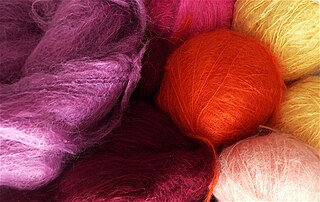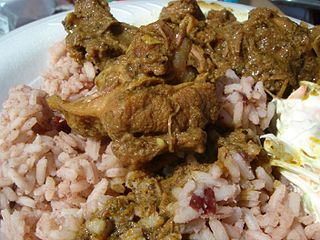Sources
"Charnequeira Goat". Archived from the original on 23 December 2008.
The Charnequeira goat breed from Portugal is used for the production of meat and milk. It is normally of a red coloration.
"Charnequeira Goat". Archived from the original on 23 December 2008.

Capricornus is one of the constellations of the zodiac. Its name is Latin for "horned goat" or "goat horn" or "having horns like a goat's", and it is commonly represented in the form of a sea goat: a mythical creature that is half goat, half fish. Its symbol is .

Mohair is a fabric or yarn made from the hair of the Angora goat. Both durable and resilient, mohair is notable for its high luster and sheen, and is often used in fiber blends to add these qualities to a textile. Mohair takes dye exceptionally well. It feels warm in winter as it has excellent insulating properties, while its moisture-wicking properties allow it to remain cool in summer. It is durable, naturally elastic, flame-resistant and crease-resistant. It is considered a luxury fiber, like cashmere, angora, and silk, and can be more expensive than most sheep's wool.

In the Bible, the name Azazel appears in association with the scapegoat rite; the name represents a desolate place where a scapegoat bearing the sins of the Jews during Yom Kippur was sent. During the end of the Second Temple period, his association as a fallen angel responsible for introducing humans to forbidden knowledge emerged due to Hellenization, Christian narrative, and interpretation exemplified in the Book of Enoch. His role as a fallen angel partly remains in Christian and Islamic traditions.

The subfamily Caprinae is part of the ruminant family Bovidae, and consists of mostly medium-sized bovids. A member of this subfamily is called a caprine, or, more informally, a goat-antelope; however, this term "goat-antelope" does not mean that these animals are true antelopes: a true antelope is a bovid with a cervid-like or antilocaprid-like morphology.

Goat cheese, or chèvre, is cheese made from goat's milk. Goat cheeses are made in a wide variety of styles, from soft fresh cheese to hard aged cheese.

Cashmere wool, usually simply known as cashmere, is a fiber obtained from cashmere goats, pashmina goats, and some other breeds of goat. It has been used to make yarn, textiles and clothing for hundreds of years. Cashmere is closely associated with the Kashmir shawl, the word "cashmere" deriving from an anglicisation of Kashmir when the Kashmir shawl reached Europe in the 19th century from Colonial India. Common usage defines the fiber as wool, but it is finer, stronger, lighter, softer and approximately three times more insulating than sheep wool. Both the soft undercoat and the guard hairs may be used; the softer hair is reserved for textiles, while the coarse guard hair is used for brushes and other non-apparel purposes.
The Curse of the Billy Goat was a sports-related curse that was supposedly placed on the Chicago Cubs Major League Baseball (MLB) franchise in 1945, by Billy Goat Tavern owner William Sianis. The curse lasted 71 years, from 1945 to 2016. His pet goat, named Murphy, was bothering other fans, Sianis was asked to leave Wrigley Field, the Cubs' home ballpark, during game 4 of the 1945 World Series. Outraged, Sianis allegedly declared, "Them Cubs, they ain't gonna win no more," which had been interpreted to mean that the Cubs would never win another National League (NL) pennant, at least for the remainder of Sianis's life.

The mountain goat, also known as the Rocky Mountain goat, is a hoofed mammal endemic to North America. A subalpine to alpine species, it is a sure-footed climber commonly seen on cliffs and ice.

Tanngrisnir and Tanngnjóstr are the goats who pull the god Thor's chariot in Norse mythology. They are attested in the Poetic Edda, compiled in the 13th century from earlier traditional sources, and the Prose Edda, written by Snorri Sturluson in the 13th century.

Capra is a genus of mammals, the goats, composed of up to nine species, including the wild goat, the markhor, and several species known as ibexes. The domestic goat is a domesticated subspecies of the wild goat. Evidence of goat domestication dates back more than 8,500 years.

The Mountain Goats are an American band formed in Claremont, California, by singer-songwriter John Darnielle. The band is currently based in Durham, North Carolina. For many years, the sole member of the Mountain Goats was Darnielle, despite the plural moniker. Although he remains the core member of the band, he has worked with a variety of collaborators over time, including bassist and vocalist Peter Hughes, drummer Jon Wurster, multi-instrumentalist Matt Douglas, singer-songwriter Franklin Bruno, bassist and vocalist Rachel Ware, singer-songwriter/producer John Vanderslice, guitarist Kaki King, and multi-instrumentalist Annie Clark.

The wild goat is a wild goat species, inhabiting forests, shrublands and rocky areas ranging from Turkey and the Caucasus in the west to Turkmenistan, Afghanistan and Pakistan in the east. It has been listed as near threatened on the IUCN Red List and is threatened by destruction and degradation of habitat.

Curry goat is a curry dish prepared with goat meat, originating from the Indian subcontinent and Southeast Asia. The dish is a staple in Southeast Asian cuisine, Caribbean cuisine, and cuisine of the Indian subcontinent. In Southeast Asia, the dish was brought by Indian diaspora in the region, and subsequently has influenced local cuisine. This dish has spread throughout the Caribbean and also the Indo-Caribbean diaspora in North America and Europe.

The Yule goat is a Scandinavian and Northern European Yule and Christmas symbol and tradition. Its origin may be Germanic pagan and has existed in many variants during Scandinavian history. Modern representations of the Yule goat are typically made of straw.

Capricorn(♑︎) is the tenth astrological sign in the zodiac out of twelve total zodiac signs, originating from the constellation of Capricornus, the horned goat. It spans the 270–300th degree of the zodiac, corresponding to celestial longitude. Under the tropical zodiac, the sun transits this area from about December 21 to January 21 the following year, and under the sidereal zodiac, the sun transits the constellation of Capricorn from approximately January 16 to February 16. In astrology, Capricorn is considered an earth sign, negative sign, and one of the four cardinal signs. Capricorn is said to be ruled by the planet Saturn.

Goat meat or goat's meat is the meat of the domestic goat (Capra aegagrus hircus). The common name for goat meat is simply "goat", though meat from adult goats is referred to as chevon, while that from young goats can be called capretto (It.), cabrito (Sp.) or kid. In South Asian and Caribbean cuisine, mutton commonly means goat meat. In South Asia, where mutton curry is popular, "mutton" is used for both goat and lamb meat. The United States Department of Agriculture promoted the term "chevon", a portmanteau of chèvre ('goat') and mouton in the 1920s. According to market research, consumers in the United States prefer the pseudo-French-language-derived culinary name "chevon". "Cabrito", a word of Spanish and Portuguese origin, refers specifically to the meat of a young, milk-fed goat. It is also known as chivo.

The domestic goat or simply goat is a subspecies of C. aegagrus domesticated from the wild goat of Southwest Asia and Eastern Europe. The goat is a member of the animal family Bovidae and the subfamily Caprinae, meaning it is closely related to the sheep. There are over 300 distinct breeds of goat. It is one of the oldest domesticated species of animal, according to archaeological evidence that its earliest domestication occurred in Iran at 10,000 calibrated calendar years ago.

In the Bible, a scapegoat is one of two kid goats. As a pair, one goat was sacrificed and the living “scapegoat” was released into the wilderness, taking with it all sins and impurities. The concept first appears in Leviticus, in which a goat is designated to be cast into the desert to carry away the sins of the community.
Then Aaron shall lay both his hands on the head of the live goat, and confess over it all the iniquities of the people of Israel, and all their transgressions, all their sins, putting them on the head of the goat, and sending it away into the wilderness by means of someone designated for the task. The goat shall bear on itself all their iniquities to a barren region; and the goat shall be set free in the wilderness.